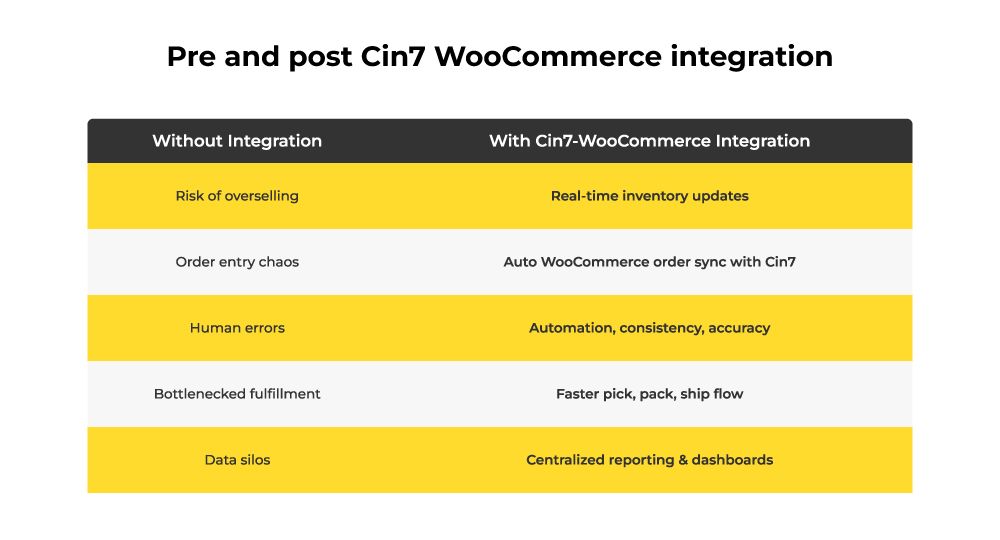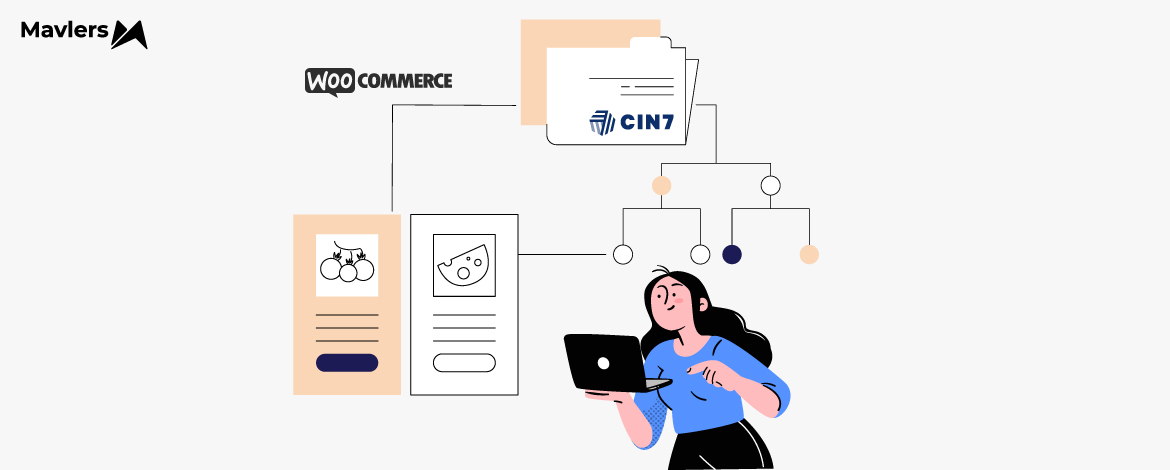So, you are an e-commerce biz owner with a WooCommerce store that’s picking up steam. Sales are pouring in, new SKUs are being added weekly, and inventory’s moving fast.
But here’s the flip side…
Your backend is chaos.

You’re constantly double-checking stock. Orders are slipping through cracks. And your team? Well, they’re buried in spreadsheets trying to piece together what’s actually in stock vs. what’s just been sold.
Sound familiar?
If you’re nodding your head, then here’s the good news: Cin7 and WooCommerce integration might just be the operational upgrade your store desperately needs.
This isn’t some pie-in-the-sky “future-proofing” gimmick. This is about building a central nervous system for your business, one that syncs inventory in real-time, automates order processing, and frees you (and your team) from the tyranny of manual data entry.
With over 13 years of experience & expertise in the web development field, we will help you break down exactly how Cin7 connects with WooCommerce, what it does, why it matters, and how to set it up like a pro.
But first, what is Cin7 and why should one care?
For starters, Cin7 isn’t just another inventory tool. It’s an all-in-one cloud-based inventory and order management platform designed for serious e-commerce players who sell across multiple channels, like WooCommerce, Amazon, physical stores, B2B, and more.
It acts like the brain of your operation, by keeping track of inventory, automating orders, managing your warehouses, syncing pricing, and keeping every channel updated in real-time.
Here’s why that matters:
- No more overselling (and refund apologies)
- No more duplicate entries between systems
- No more slow fulfillment due to disconnected data
With Cin7, you get a unified platform to manage everything seamlessly.
Why integrating WooCommerce with Cin7 can be a game-changer
Now, let’s talk about what happens when you connect Cin7 with WooCommerce.
This isn’t a loose handshake; it’s a two-way sync that can automate nearly every step between your online storefront and your warehouse.
Here’s how it transforms your workflow:
1. Inventory sync that just works
When someone buys from your WooCommerce store, Cin7 deducts that stock instantly. When new inventory lands in your warehouse and gets logged into Cin7, your WooCommerce stock is updated in real-time.
You’re always selling what’s actually available. No guesswork, no hits & misses.
2. WooCommerce order sync with Cin7
Every new order placed on WooCommerce flows automatically into Cin7. From there, your warehouse team gets the green light to pick, pack, and ship, while Cin7 pushes real-time order status updates back to WooCommerce.
On one hand, customers stay informed, while your team stays sane.
3. WooCommerce product sync with Cin7
Cin7 is your product catalog HQ. You can push SKUs, images, descriptions, pricing, and even product variants directly into WooCommerce.
Important caveat: Changes made within WooCommerce won’t automatically update Cin7. You’ll need to initiate that sync manually (more on that later).
4. Pricing sync (With some quirks)
You can set up multiple pricing tiers, such as retail and wholesale, directly inside Cin7 and push them to WooCommerce. Please note that this might get tricky. Price sync isn’t always perfect, so test carefully and follow Cin7’s pricing guide if you’re setting up advanced pricing rules.
But is this integration really worth it?
Short answer, yes! Well, if you’re serious about scaling.
If you are still managing orders, inventory, and product updates manually, here’s what you’re risking:

How to set up Cin7 WooCommerce integration
Alright, let’s walk through the setup. It’s not rocket science, but there are a few moving parts, so grab a coffee, take a breath, and follow along step-by-step.
Step 1: First, get your WooCommerce API keys
These keys are basically how Cin7 talks to your WooCommerce store securely, like handing over the Wi-Fi password so they can sync up behind the scenes.
Here’s what you do:
- Head to your WordPress dashboard
- Go to WooCommerce → Settings → Advanced → REST API
- Click “Add Key”
- Give it a name (anything works, “Cin7 Sync” is fine)
- Set the permissions to Read/Write
- Click “Generate API Key,” then copy your Consumer Key and Secret (save them somewhere safe, you’ll need them shortly)
Step 2: Add the WooCommerce app in Cin7
Now hop over to Cin7.
- Log in as an admin
- Go to the App Store or the Integrations section
- Look for “WooCommerce” in the list of apps
- Click Install or Request Installation if it’s not available right away
This gets the connector ready to pair up with your store.
Step 3: Connect the two platforms
Here comes the handshake.
- Go into the WooCommerce integration settings inside Cin7
- Paste in your WooCommerce store URL
- Then drop in the Consumer Key and Secret you saved earlier
- Follow any prompts, and it’ll walk you through completing the connection.
Once done, Cin7 and WooCommerce are officially in sync mode.
Step 4: Customize what gets synced
Here’s where you can fine-tune the setup to match your business.
Inside the Cin7 WooCommerce settings, you’ll decide:
- Which way the data flows: Want products to go from Cin7 to WooCommerce? Orders from WooCommerce to Cin7? Or both?
- How stock levels are calculated: Especially important if you manage multiple warehouses
- How order statuses and payment methods match up: You can map things like “Paid” in WooCommerce to “Awaiting Shipment” in Cin7
- Pricing tiers: If you have different prices for retail vs. wholesale, you can set rules here
Take your time here. This step sets the foundation for clean data and smooth automation.
Step 5: Test, tweak, repeat
Before you go live, test everything.
Here’s your quick checklist:
- Place a fake order on your WooCommerce store
- Log new stock into Cin7
- Push a sample product from Cin7 to WooCommerce
- Check if everything is syncing the way it should, inventory levels, order updates, pricing, the whole deal
Don’t skip this. A solid test run now saves you from last-minute surprises later.
Also, always refer to the official Cin7 documentation for the most detailed and up-to-date setup instructions, as steps may vary slightly with software updates.
Who this integration is actually for
Let’s cut to the chase, this integration isn’t for every WooCommerce store.
If you’re running a small shop with a few SKUs and fulfilling everything from your garage, you might not need something as robust as Cin7 just yet.
But if any of this sounds familiar, you might wanna reconsider:
- You’re selling in more than one place—WooCommerce, Amazon, maybe a retail store or a wholesale portal, and keeping everything in sync is starting to feel like a full-time job
- You’ve got inventory spread across different locations, and things occasionally (or often) fall through the cracks
- Your product line is expanding, and it’s getting harder to keep track of what’s live, what’s in stock, and what’s already sold
- You’re spending way too much time on stuff that should be automated, you know, like updating prices, checking stock, or entering orders manually
- You’re tired of telling customers, “Sorry, we just sold out,” when your site said it was in stock
If you’re nodding along to any of that, Cin7 isn’t just a nice-to-have, it’s a lifeline.
Because once your store reaches a certain level of complexity, running things manually simply doesn’t suffice anymore. This integration gives you back control, clarity, and time.
And that’s what really scales.
The road ahead
If you want to know whether Shopify or WooCommerce might be the right fit for your next business endeavour, you might want to read ~ Shopify vs. WooCommerce: Pros, Cons, and What Works Best for Your Business.


Rumani Sharma - Subject Matter Expert (SME)
As a Project Lead with over 6 years of project management experience, she specializes in aligning project objectives with broader business goals to deliver impactful solutions. With a strong focus on WordPress development, she ensures that every website is not only functional and user-friendly but also tailored to exceed client expectations. Her expertise spans client communication, agile workflows, quality assurance, and team coordination, making her a reliable bridge between strategy and execution. Passionate about continuous improvement, she brings clarity, structure, and creativity to every project she leads.
Naina Sandhir - Content Writer
A content writer at Mavlers, Naina pens quirky, inimitable, and damn relatable content after an in-depth and critical dissection of the topic in question. When not hiking across the Himalayas, she can be found buried in a book with spectacles dangling off her nose!
AI-Powered Resource Page Link Building: Smart Strategy or Just Another Spamfest?
Why Shopify Doesn’t Use Parent-Child Categories (And What to Do Instead)